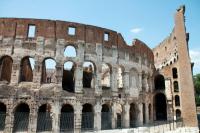Structure and diseases of the horse's hoof
Many people seek happiness on earth on their four-legged partner, the horse. The animals should carry us over hill and dale, and walk safely on asphalt and forest floor. But not only the horse's back is stressed, but also the hooves. But how does a hoof have to be constructed to be so resilient?
The layers of the hoof wall
In principle, a hoof is not constructed any differently than a claw or a fingernail. Like sweat glands or hair, hooves are modified skin. Therefore, the three layers of the skin are also preserved: subcutaneous tissue, dermis and epidermis. However, this epidermis is very horny, which is how the hoof is formed.
- The heart of the hoof is the coffin bone. This corresponds to the last human finger bone. In horses, only one of the five toes is fully developed - the third toe. The outer ones are no longer created, rudimentary bones, the so-called stylus bones, are left of the second and fourth.
- The subcutaneous tissue is placed over this bone. This is rich in fat and not strongly developed over the entire hoof. It serves as a support on the ball of the foot with large fat pads and is also formed on the hem segment, i.e. at the upper end of the hoof.
- The skin and epidermis are attached to either the subcutaneous tissue or the bones. The epidermis, like everywhere else on the body, forms keratin, albeit in large quantities, arranged as a lamellar or tubular horn.
- On the underside of the hoof is the ball segment, which is formed in the rear part of the hoof, and the sole segment, which makes up the main part of the underside of the hoof.
- The hoof wall is formed by the coronet segment, the horn of which grows from top to bottom, and mainly by the wall segment. The lower end of this segment is called the supporting rim.
A horse's hooves must be well cared for, because on bad or sick ...
Hoof mechanics - how the hoof can carry the load
- There are notches on the sole that delimit a triangle. This is called the frog and the notches are the two lateral and the middle frog furrow, which are regularly scraped out.
- The rear ends of the hoof wall are called heels. Their position and their distance from one another say a lot about the horse's hoof health.
- If a load is picked up, i.e. the horse puts weight on the hoof, the frog is so elastic that it can be pressed against the ground. The costumes drift apart.
- In addition, the coffin bone is firmly anchored in the collagen fibers that emanate from the dermis
So the hoof, even if it doesn't look like it, is not a rigid structure.
Diseases of the hoof apparatus
Most Horses are held differently than nature intended for them. Malnutrition, wrong stress and wrong attitude can lead to hoof problems.
- The soft horn of the frog can be attacked by a damp subsurface, which leads to thrush. Regular hoof care and suitable bedding can prevent this condition.
- The most well-known disease of the hoof is probably deer, which can be caused by many different factors, including poor diet or medication. It is an inflammation of the dermis. In the worst case, the disease can lead to the coffin bone loosening from its anchorage and breaking out of the hoof shoe. Deer can be recognized by the widening of the "white line", the transition between the support edge and the sole.
- Hoof abscesses are also not uncommon and very painful for the animals. These can occur, for example, with nailed horseshoes.
- Many other diseases of the hoof, such as cracks in the horn or ulcers, can be prevented through improved housing conditions and care
You have to think twice: Horses walk on the fingernail of their middle finger! We who use our entire foot to run are in pain when a toenail is injured, horses have to stand on it all the time. It is therefore important to pay close attention to the hooves of these animals and to consult professional hoof trimmers.


